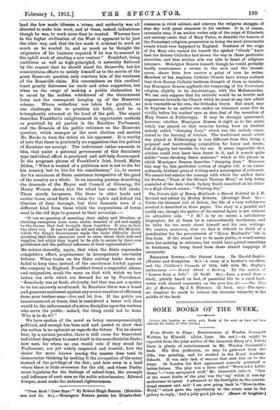"Comet Reek! Come Rope!" By Robert Hugh Benson. (Hutchin- !:sion..and
Co. 6s.).—Monsignor Benson-paints his Elizabethan romances in vivid colours; and conveys the religions struggle of that day with great clearness to his readers. It is, of course, extremely easy, if an author writes only of the reign of Elizabeth and entirely omits that of Mary Tudor, to describe the horrors of the Protestant religious persecution as being the most abominable events which ever happened in England. Students of the reign of the Mary who earned for herself the epithet "bloody" know that the Roman Catholics had shown the way in these particular atrocities, and that neither side was able to boast of religious tolerance. Monsignor Benson himself, though he would probably hardly countenance a return to the rack and the thumb- screw, shows from how narrow a point of view he writes. Members of the Anglican Catholic Church have always realized that their Roman Catholic brethren thought of them as heretics, but Monsignor Benson applauds the comparing of the Protestant religion, slightly to its disadvantage, with the Mohammedan. We can only suppose that his attitude would be as hostile and ungenerous towards the Church which he must at any rate admit is as venerable as his own, the Orthodox Greek. But much may be forgiven to an author who makes an historical scene live as vividly before his readers' eyes as does that of the execution of Mary Stuart at Fotheringay. It may be strongly questioned, however, whether Monsignor Benson is right as to the music which was played on that occasion having been an insolent melody called "Jumping Joan," which was the melody conse- crated to the burning of witches. The traditional music which was played at Fotheringay is very different from this, being a poignant and heartrending composition for horns and drums, full of dignity but terrible to the ear. It seems impossible that witches could ever have been burnt to it, and it sounds quite unlike "some shocking dance measure," which is the phrase in which Monsignor Benson describes "Jumping Joan." However this may be, this particular section of chapter viii. is an extra- ordinarily brilliant piece of writing and a masterpiece of reticence. We cannot but admire the courage with which the author dates his Preface, "Feast of the Blessed Thomas More," or help being reminded of the date which Sydney Smith inscribed on his letter to a High Church curate: "Washing day."










































 Previous page
Previous page